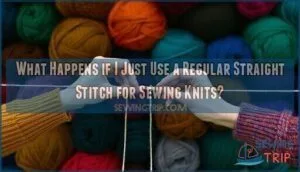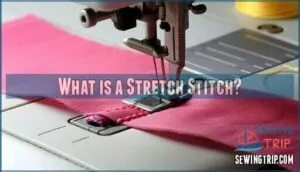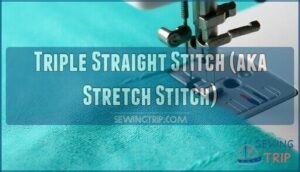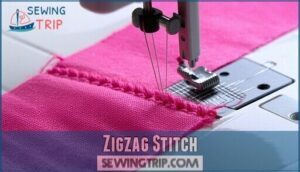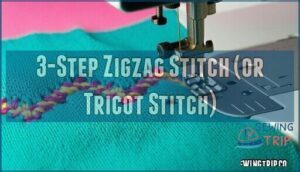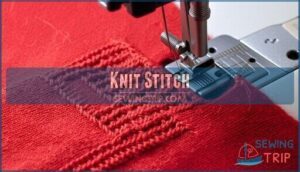This site is supported by our readers. We may earn a commission, at no cost to you, if you purchase through links.
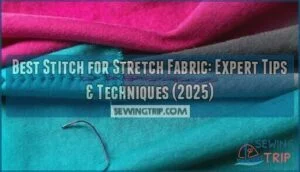 The zigzag stitch reigns supreme as the best stitch for stretch fabric, giving your seams room to breathe while maintaining durability.
The zigzag stitch reigns supreme as the best stitch for stretch fabric, giving your seams room to breathe while maintaining durability.
This flexible workhorse prevents those dreaded broken threads when you bend, stretch, or move in your handmade activewear. You’ll want to set your machine to a moderate width and length – think Goldilocks territory, not too tight, not too loose.
The triple straight stitch also deserves honorable mention for its reinforced strength, while the 3-step zigzag works magic on super stretchy materials like spandex.
Your fabric type, project purpose, and machine capabilities all play matchmaker in this stitch selection game. But mastering tension settings can make even basic stitches perform like champions.
Table Of Contents
- Key Takeaways
- Do Stitches Stretch?
- What Happens if I Just Use a Regular Straight Stitch for Sewing Knits?
- What is a Stretch Stitch?
- What Are Some Types of Stretch Stitches on a Sewing Machine?
- What is a Lightning Stitch?
- Triple Straight Stitch (aka Stretch Stitch)
- Zigzag Stitch
- 3. Step Zigzag Stitch (or Tricot Stitch)
- 2. Step Zigzag Stitch
- Knit Stitch
- Frequently Asked Questions (FAQs)
- Conclusion
Key Takeaways
- You’ll want to use the zigzag stitch as your go-to choice for stretch fabrics since it flexes with the material’s movement and prevents thread breakage, unlike straight stitches that snap under pressure.
- You should pair a ballpoint needle with polyester thread when sewing stretch fabrics, as this combination prevents snagging and provides the flexibility needed for durable seams that won’t pop.
- You can choose the triple straight stitch for maximum durability on heavyweight knits, or the 3-step zigzag for finishing edges and preventing fraying on super stretchy materials like spandex.
- You must adjust your tension settings and stitch length based on your fabric’s stretch percentage – wider settings work for heavy knits while narrower widths suit delicate jerseys.
Do Stitches Stretch?
Why do some seams snap while others move with you like a second skin? The answer lies in stitch elasticity. Not all stitches are created equal in regards to fabric movement.
Regular straight stitches act like rigid chains, breaking under pressure when your stretch fabric extends. However, the right sewing machine stitches actually give and take with your fabric’s natural movement.
Stretch stitches bend with your fabric like a dance partner, while straight stitches snap like brittle branches.
Seam flexibility depends on matching your thread type to your fabric’s stretch percentage. Polyester thread offers some give, while cotton thread stays stubborn and snaps.
The best sewing stitch for knit fabric creates stretch fabric seams that flex without breaking. Think of it as building a bridge that sways in the wind rather than one that cracks. This stitch durability comes from choosing stitches designed to move with your fabric, not against it.
What Happens if I Just Use a Regular Straight Stitch for Sewing Knits?
Using a regular straight stitch on knit fabrics will likely cause your threads to snap when the fabric stretches, since straight stitches can’t flex with the material’s natural movement.
You’ll end up with broken seams, puckered fabric, and frustrated sighs as your carefully sewn garment falls apart at the first stretch, resulting in a poor experience due to the lack of flexibility.
Types of Stretch Fabrics
Not all stretch fabrics behave the same way.
Understanding Knit Fabric Types helps you choose the right approach for your project. Jersey offers about 30% stretch and works perfectly for casual wear, while lycra and spandex deliver 30-50% stretch for activewear. Double knit provides minimal rolling with medium weight.
A variety of options are available when you buy stretch knits.
Here’s your Stretch Percentage Guide:
- Jersey knit fabric – 30% stretch, lightweight, ideal for t-shirts
- Lycra/spandex blends – 30-50% stretch, perfect for leggings
- Double knit – Medium weight, minimal stretch, great stability
Benefits of Using Stretchy Fabrics for Sewing Projects
Working with stretch fabric opens up a world of possibilities that’ll transform your sewing game.
You’ll discover incredible comfort and fit that moves with your body, plus versatility that adapts to any project.
The natural drape quality creates flattering silhouettes while wrinkle resistance keeps garments looking fresh.
Easy care means less fussing with maintenance, making stretch fabric sewing perfect for busy lifestyles.
| Benefit | Why It Makes Sewing Life Better |
|---|---|
| Comfort & Movement | Your clothes won’t fight back when you bend or stretch |
| Forgiving Fit | Hides fitting mistakes and flatters various body shapes |
| Time-Saver | Less ironing needed thanks to natural wrinkle resistance |
| Beginner-Friendly | Mistakes are less noticeable with stretchy fabric projects |
| Durability | Knit fabric stitch techniques create garments that last longer |
What is a Stretch Stitch?
Think of a stretch stitch as your fabric’s best friend—it moves when your material moves. Unlike regular straight stitches that snap under pressure, stretch stitches provide the flexibility your knit fabrics need to maintain their shape and comfort.
Your seams should dance with your fabric, not fight against it—that’s the secret to stretch stitch success.
A stretch stitch is specifically engineered for sewing stretchy fabric, offering superior stitch flexibility while maintaining seam strength. These specialized stitches accommodate fabric movement without breaking or creating puckered seams that ruin your project.
Here’s what makes stretch stitches essential for knit fabric stitch work:
- Prevents thread breakage when fabric stretches during wear
- Maintains seam integrity through washing and repeated stretching
- Reduces puckering that occurs with inappropriate needle type choices
- Allows proper thread tension adjustment for different fabric weights
- Creates professional-looking finished garments that move naturally
When you’re sewing knit fabric, the zig zag stitch and other stretch variations work by creating small loops or multiple thread paths. This design lets your seams flex without compromising durability, making your handmade garments as comfortable as store-bought alternatives. Many sewers find success with specific stitch products designed for stretch applications.
What Are Some Types of Stretch Stitches on a Sewing Machine?
When sewing stretchy fabric, your machine offers several stretch stitch options that’ll keep your knits looking professional.
The zigzag stitch remains the most versatile choice, allowing fabric movement without breaking threads.
For heavyweight knits, try the triple straight stitch, which creates three parallel rows for extra durability.
The 3-step zigzag stitch works beautifully for finishing raw edges, while the 2-step version prevents tunneling on bias cuts.
Don’t overlook decorative options like the honeycomb stitch for topstitching or the overedge stitch that finishes seams in one pass.
Your walking foot helps feed fabric evenly, preventing stretching during stitching.
Twin needle techniques create professional hems with parallel rows on top and zigzag underneath.
Serger stitches on regular machines mimic overlock finishes.
Adjust your stitch length based on fabric weight – shorter for lightweight jerseys, longer for heavy knits.
Stretch stitches are essential for preventing popped stitches on these fabrics.
Each stitch serves specific purposes in sewing knit fabric successfully.
What is a Lightning Stitch?
The lightning bolt stitch earns its name from its distinctive zigzag pattern that resembles a bolt of electricity.
This stretch stitch moves diagonally up and down while going forward and back as it stitches, creating remarkable stitch elasticity for sewing stretchy material.
Here’s why lightning stitch uses make it the best stitch for stretch fabric:
- Needle position adjusts automatically to create flexible seams
- Tension settings work perfectly with polyester thread
- Seam appearance stays smooth without puckering
- Prevents thread breakage when fabric stretches
- Works beautifully on both lightweight and heavy knits
- Creates professional-looking hems that move with you
This stitch is often referenced in knit sewing tutorials.
This versatile stretch stitch keeps your seams strong while allowing natural fabric movement—exactly what you need for comfortable, long-lasting garments.
Triple Straight Stitch (aka Stretch Stitch)
You’ve explored the lightning stitch’s zigzag magic, but now let’s meet its structured cousin: the triple straight stitch.
This powerhouse creates three parallel rows of stitching that look like a miniature highway on your fabric. Your sewing machine settings will show this as a straight stretch stitch or backstitch option.
Here’s what makes this stitch special for stretch fabric: it penetrates the same holes multiple times, building inherent flexibility. When you’re working with jersey or lightweight knits, this stitch won’t snap under pressure like regular straight stitches do.
| Aspect | Details |
|---|---|
| Seam Durability | Excellent for high-stress areas |
| Stitch Appearance | Three neat parallel lines |
| Fabric Types | Best for lightweight to medium knits |
Adjust your tension settings and needle choice based on fabric weight. The triple straight stitch offers impressive strength while maintaining that essential stretch your knits need to move naturally.
Zigzag Stitch
Master sewers know the zigzag stitch is their trusty companion when tackling stretch fabric projects. This fundamental sewing machine stitch moves side-to-side, creating flexibility that won’t snap under pressure.
You’ll want to adjust your zigzag width to match your fabric’s stretch—wider settings work beautifully for heavy knits, while narrow widths suit delicate jerseys.
The magic happens in three key areas that’ll transform your sewing game:
- Stitch flexibility that moves with your fabric instead of fighting against it
- Seam finishing that prevents fraying while maintaining stretch integrity
- Decorative zigzag options that add professional polish to visible seams.
Set your stitch density between 2.5-3mm for ideal results. This versatile technique works equally well for applique technique projects and basic construction.
Unlike straight stitches that create rigid lines, zigzag stitches bend and flex with your garment’s natural movement, preventing those dreaded popped seams.
3. Step Zigzag Stitch (or Tricot Stitch)
The 3-step zigzag stitch acts like a gentle embrace for your stretch fabric, offering stability without strangling the material’s natural give.
This tricot stitch creates three forward movements followed by three backward ones, forming a dense zigzag pattern that’s perfect for finishing edges and preventing fraying.
Adjust your stitch width to control how far the needle swings left and right, while stitch length determines spacing between each zigzag cluster.
Your sewing machine settings should use a ballpoint needle and moderate tension.
This stretch stitch excels at hemming knits and securing seams that won’t pop when fabric type demands flexibility, making it ideal for sewing stretchy fabric applications.
2. Step Zigzag Stitch
The 2-step zigzag stitch conquers lightweight knits with finesse, delivering clean hems without the dreaded tunneling effect.
This versatile stretch stitch adapts perfectly to delicate fabrics that would disappear under heavier alternatives.
Here’s why you’ll love this sewing machine setting:
- Gentle precision – The narrower stitch width prevents overwhelming thin materials
- Balanced flexibility – Ideal stitch length maintains seam strength while allowing movement
- Effortless application – Simple sewing stitches that work consistently across fabric types
When sewing stretchy fabric, this zigzag stitch variant reinforces edges through controlled back-and-forth motion.
The applications overview shows it’s ideal for hemming jersey knits, finishing seams on activewear, and creating professional-looking garments.
You’ll find the stitch width perfectly sized for lightweight materials, making it your go-to choice.
Knit Stitch
The knit stitch acts like your fabric’s best friend when working with jersey and other stretchy materials.
This specialized sewing machine setting creates a narrow zigzag pattern that moves with your knit fabric instead of fighting against it.
Knit Stitch Uses extend beyond basic seams – you’ll find it perfect for hems, topstitching, and finishing edges on lightweight stretch fabric.
The beauty lies in its Knit Stitch Durability; seams won’t pop when you pull on your finished garment.
For ideal Knit Stitch Tension, pair a ballpoint needle with polyester thread.
Set your stitch length to 2.5-3mm to prevent fabric bunching.
This stretch stitch prevents that annoying tunneling effect you’ve probably encountered before.
Knit Stitch Variations include adjusting the width for different fabric weights.
While Knit Stitch Alternatives like zigzag work well, the knit stitch specifically targets the unique needs of stretchy fabrics, making your sewing stitches more professional-looking.
Frequently Asked Questions (FAQs)
What stitch should I use on stretch fabric?
About 90% of sewers struggle with puckered seams on stretchy fabrics.
You’ll want zigzag or stretch stitches that flex with your fabric’s movement.
Skip straight stitches—they’ll snap under stress, leaving you frustrated.
Is there a trick to sewing stretchy fabric?
Sewing stretchy fabric is easier if you use a stretch needle, polyester thread, and a zigzag or stretch stitch.
Go slow, adjust presser foot pressure, and try a walking foot to prevent fabric slipping.
What is the strongest stretch stitch?
Like Hercules wielding his club, you’ll want the triple straight stitch for maximum strength.
This powerhouse creates three parallel rows of straight stitches, giving you unbeatable durability while maintaining the stretch your fabric needs.
What setting do you use for stretchy fabric on a sewing machine?
You’ll want to use a ballpoint needle, polyester thread, and select either zigzag or stretch stitch settings.
Reduce presser foot pressure slightly and slow your sewing speed to prevent fabric from stretching or puckering during construction.
How do I know how much stretch my fabric has?
Test your fabric’s stretch by pulling a 4-inch section.
If it stretches to 5 inches, that’s 25% stretch.
Measure both horizontally and vertically to determine if you’ve got 2-way or 4-way stretch fabric.
What kind of thread should I use for stretch fabrics?
Nearly 70% of sewing projects fail because of wrong thread choice.
You’ll want polyester thread for stretch fabrics—it’s got just enough give to move with your fabric without snapping under pressure.
How can I prevent my seams from popping when sewing stretch fabrics?
Use stretch stitches like zigzag or lightning bolt instead of straight stitches.
They’ll flex with your fabric’s movement.
Also, don’t pull or stretch the fabric while sewing—let the machine do the work naturally.
Are there any special techniques I should use when sewing stretch fabrics?
Stretch fabrics need ballpoint needles to slip between fibers without snagging.
Pre-wash your fabric, use zigzag or stretch stitches, and sew slowly with steady pressure.
A walking foot prevents fabric from bunching up.
What needle type works best for stretch fabrics?
Sharp needles might seem logical, but they’ll actually damage your stretchy fabrics.
You’ll want ballpoint or stretch needles instead—their rounded tips slide between fibers rather than piercing them, preventing snags and skipped stitches, which makes them a better choice for working with stretchy fabrics.
How do I prevent fabric from curling while sewing?
Lightweight knits love to curl at edges, but you can tame them easily.
Apply spray starch to curling edges, then press with an iron to flatten them before cutting or sewing your project.
Conclusion
Surprisingly, many sewers discover the best stitch for stretch fabric just when they’re about to give up on their project.
You’ve now got the knowledge to choose wisely between zigzag, triple straight, and specialty stitches.
Remember, your fabric’s stretch percentage and project requirements should guide your decision.
Don’t forget to adjust tension settings – they’re often the secret ingredient that transforms good stitching into great results.
Start with these techniques, and you’ll be creating professional-quality stretch garments in no time.
- https://sewingmachinetalk.com/best-stitch-stretchy-fabric/
- https://coppercreekpatterns.com/blogs/knit-sewing-techniques/the-best-stretch-stitches-on-your-sewing-machine
- https://sewing.patternreview.com/SewingDiscussions/topic/104072
- https://sewpdf.com/blog/choosing-a-stretch-stitch-for-sewing-knit-fabric
- https://matchymatchysewingclub.com/blogs/sewing-club/tips-for-sewing-with-knits

